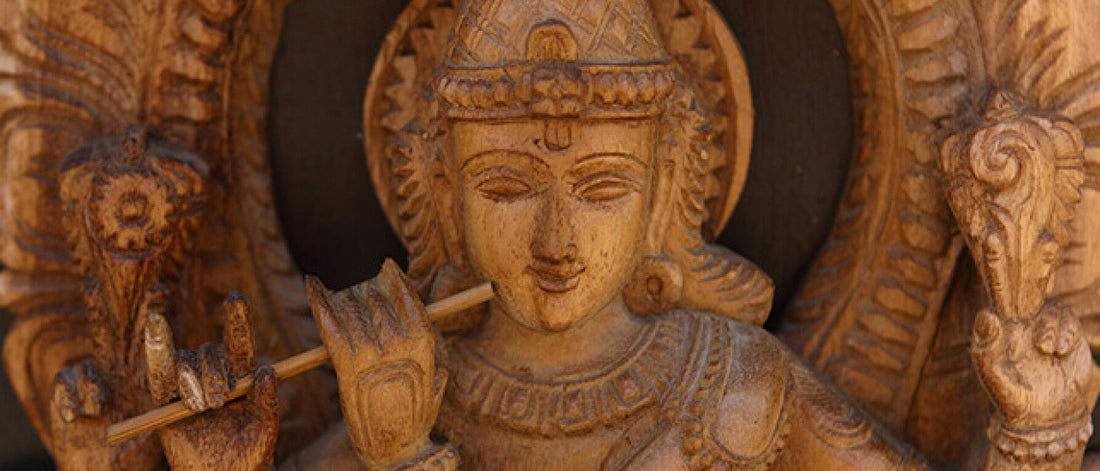We are surrounded by archetypes: those recurrent symbols found in art, literature, modern-day movies, television soap operas, tabloid newspapers, mythology, and even regular everyday people.
These archetypes—including those found in the Vedic tradition—can be valuable assistants in your life. An archetype can be anyone who has traits that you admire or would like more of in your life. And they play valuable roles in your relationships and spirituality as well as help shape your values and true potential.
Archetypes can be a source of inspiration or act as a role model as you set out to achieve a particular goal or make a lifestyle change. You can call upon an archetype that you identify with or look up to in times of need or to help in your meditation or yoga practice.
These themes have existed forever. We see them in the writings of ancient cultures, in literature throughout the ages, and today in the modern world, they exist in comics, movies, and in TV. Their shapes shift depending on where we are in history, but their core themes and lessons remain the same.
Once you’ve embraced an archetype or archetypes, they become a part of your individual psyche. Archetypes can be divine or diabolical, sacred or profane, the sinner or the saint, the adventurer, the sage, the seeker, the rescuer, the love object, and the redeemer. These are all exaggerated expressions of the conscious energy of the collective soul.
Archetypes are not all good or bad. All archetypes have shadow manifestations as well as positive aspects, according to author Caroline Myss. The shadow side of an archetype can have just as much power as the light side; they just need to be channeled in a positive way.
The activation of an archetype releases its patterning forces that allow us to become more of what we already are destined to be. And our individual archetypes are reflected in our desires or intentions.
There are numerous archetypes based on dieties in the Vedic tradition, including Brahma, Ganesha, and Vishnu. Brahman is considered the one divine Being responsible for all creation and manifestation. The individual deities simply represent particular aspects of the one consciousness, such as beauty, valor, wisdom, and strength. Since it’s difficult to meditate or focus on such abstract qualities, the deities provide an image or form that you can more easily visualize and hold in your mind. Whether in the form of deities or flesh-and-blood beings, animals and birds are greatly respected as aspects of the infinite god Brahman.
Meet a few of the most important ones, which you can call upon when you need inspiration.
Read more about Brahma
Read more about Ganesha
Read more about Shakti
Read more about Shiva
Read more about Vishnu
Which archetype do you identify with most?
Learn how to tap into the abundance of the universe at our signature meditation & yoga retreat, Seduction of Spirit. You’ll tune into your body’s wisdom in order to bring forth the confidence to live a life beyond your wildest dreams. Click here to learn more.
These archetypes—including those found in the Vedic tradition—can be valuable assistants in your life. An archetype can be anyone who has traits that you admire or would like more of in your life. And they play valuable roles in your relationships and spirituality as well as help shape your values and true potential.
Archetypes can be a source of inspiration or act as a role model as you set out to achieve a particular goal or make a lifestyle change. You can call upon an archetype that you identify with or look up to in times of need or to help in your meditation or yoga practice.
Where Do You Find Archetypes?
In the Vedic tradition, archetypes are perennial themes that reside at the level of the collective, universal soul. These themes are representations of our collective soul’s yearnings, imagination, and deepest desires.These themes have existed forever. We see them in the writings of ancient cultures, in literature throughout the ages, and today in the modern world, they exist in comics, movies, and in TV. Their shapes shift depending on where we are in history, but their core themes and lessons remain the same.
Using Archetypes for Inspiration
Archetypes are born of the collective soul, but they are enacted by individual souls. Their mythical dramas play out daily in our physical world. Every human being is attuned to some archetype, sometimes two or three. Every one of us is hardwired at the level of the soul to model archetypal characteristics. They are seeds sown within us.Once you’ve embraced an archetype or archetypes, they become a part of your individual psyche. Archetypes can be divine or diabolical, sacred or profane, the sinner or the saint, the adventurer, the sage, the seeker, the rescuer, the love object, and the redeemer. These are all exaggerated expressions of the conscious energy of the collective soul.
Archetypes are not all good or bad. All archetypes have shadow manifestations as well as positive aspects, according to author Caroline Myss. The shadow side of an archetype can have just as much power as the light side; they just need to be channeled in a positive way.
The activation of an archetype releases its patterning forces that allow us to become more of what we already are destined to be. And our individual archetypes are reflected in our desires or intentions.
There are numerous archetypes based on dieties in the Vedic tradition, including Brahma, Ganesha, and Vishnu. Brahman is considered the one divine Being responsible for all creation and manifestation. The individual deities simply represent particular aspects of the one consciousness, such as beauty, valor, wisdom, and strength. Since it’s difficult to meditate or focus on such abstract qualities, the deities provide an image or form that you can more easily visualize and hold in your mind. Whether in the form of deities or flesh-and-blood beings, animals and birds are greatly respected as aspects of the infinite god Brahman.
Meet a few of the most important ones, which you can call upon when you need inspiration.
Brahma (Brahman)
Brahma is the god of creation in the trinity of major gods in Hindu, which represent the three major phases of existence: creation, preservation, and destruction. Brahma is usually depicted as a bearded, four-faced, four-armed deity. The four faces represent the sacred knowledge of the four Vedas: Rig, Yajur, Sama, and Atharva. The faces symbolize that Brahma is the source of all knowledge needed for the creation of the universe and the arms represent the four directions illustrating Brahma’s omnipotence. Brahma symbolizes the universal mind.Read more about Brahma
Ganesha
Ganesha is one of the most distinctive Hindu deities, with his large elephant head and pot-bellied human body. Known as the Remover of Obstacles, Ganesha has a dual role of removing obstacles as well as creating obstructions for those whose ambitions have become destructive. Ganesha is known for his intelligence, cleverness, power, and compassion.Read more about Ganesha
Shakti
Shakti is one of the most important goddesses in the Hindu pantheon. She is the wife of Shiva, the Hindu god of destruction and rejuvenation, and represents divine feminine energy. She also takes many forms and names. As Parvati, she is honored as the mother goddess whose union with Shiva produced two sons: Kumara, who conquered the demon Taraka, and Ganesha.Read more about Shakti
Shiva (Om)
Shiva, another member of the Hindu trinity, is known as the destroyer and the protector. Shiva means “the auspicious one” in Sanskrit and is viewed as a positive force because he destroys evil, ignorance, and death. Shiva also ensures the cycle of life because he destroys negativity. Call on Shiva when you need to clear the way for renewal and growth.Read more about Shiva
Vishnu
Vishnu is the final part of the Hindu trinity of gods who represent the three phases of cosmic existence: creation, preservation, and destruction. Vishnu is the lord of preservation and sustains the universe and its laws. He protects justice and moral order by interceding in all disagreement, whether they involve humans or gods. He is also known for his patience and his gentle, merciful nature.Read more about Vishnu
Which archetype do you identify with most?
Learn how to tap into the abundance of the universe at our signature meditation & yoga retreat, Seduction of Spirit. You’ll tune into your body’s wisdom in order to bring forth the confidence to live a life beyond your wildest dreams. Click here to learn more.






















